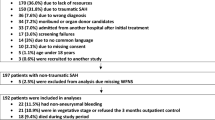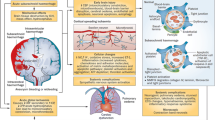Summary
The population analysed consisted of 268 out of 819 patients of a European nimodipine multicentre trial on severe head injury, whose first CT scan after injury showed signs of subarachnoid bleeding.
The study demonstrated the importance of traumatic subarachnoid haemorrhage (tSAH) per se as a prognostic factor. The outcome of patients with tSAH is significantly worse than that of patients whose first CT does not show subarachnoid blood (noSAH). The outcome was unfavourable (dead, persistent vegetative state, severe disability) in 60% of tSAH patients compared to 30% of noSAH patients (p<0.001). The difference in mortality was 42% vs. 14% (p<0.001).
The six month follow-up of tSAH patients complying with the study protocol and treated with intravenous nimodipine, 2mg per hour for 7 days, showed a statistically significant reduction of unfavourable outcome from. 66% to 51% (p<0.05), compared to placebo treated patients.
Similar content being viewed by others
References
Allen GS, Ahn HS, Preziosi TJ,et al (1983) Cerebral arterial spasm. A controlled trial of nimodipine in patients with-subarachnoid hemorrhage. N Engl J Med 308: 619–624
Chan KH, Dearden NM, Miller JD (1992) The significance of posttraumatic increase of cerebral blood flow velocity: a transcranial Doppler ultrasound study. Neurosurgery 30: 697–700
Compton JS, Teddy PJ (1987) Cerebral arterial vasospasm following severe head injury: a transcranial Doppler study. Br J Neurosurgery 1: 435–439
Dowling G, Curry B,et al (1988) Traumatic basal subarachnoid hemorrhage. Report of six cases and review of the literature. Am J Forensic Med Pathol 9: (1) 23–31
Eisenberg HM, Gary HE, Aldrich EF,et al (1990) Initial CT findings in 753 patients with severe head injury. A report from the NIH Traumatic Coma Data Bank. J Neurosurg 73: 688–698
European Study Group on Nimodipine in Severe Head Injury (1994) A multicentre trial on the efficacy of nimodipine on outcome after severe head injury. J Neurosurg 80: 797–804
Harders AH, Gilsbach JM (1987) Time course of blood velocity changes related to vasospasm in the circle of Willis measured by transcranial Doppler ultrasound. J Neurosurg 66: 718–728
Krauland W (1981) The traumatic subarachnoidal hemorrhage. Z Rechtsmed 87: 1–7
Macpherson P, Graham DI (1978) Correlation between angiographic findings and the ischaemia of head injury. J Neurol Neurosurg Psychiatry 41: 122–127
Marek Z (1981) Isolated subarachnoid hemorrhage as a medicolegal problem. Am J Forensic Med Pathol 2: 19–22
Martin NA, Doberstein C, Zone C,et al (1992) Posttraumatic cerebral arterial spasm: transcranial Doppler ultrasound, cerebral blood flow and angiographic findings. J Neurosurg 77: 575–583
Meyer CHA, Lowe D, Meyer M,et al (1983) Progressive change in cerebral blood flow during the first three weeks after subarachnoid hemorrhage. Neurosurgery 12: 58–76
Neil-Dwyer G, Mee E, Dorrance D, Lowe D (1987) Early intervention with nimodipine in subarachnoid hemorrhage. Eur Heart J 8 [Suppl K]: 41–47
öhman J, Heiskanen O (1988) Effect of nimodipine on the outcome of patients after aneurysmal subarachnoid hemorrhage and surgery. J Neurosurg 69: 683–686
Pickard JD, Murray GD, Illingworth R,et al (1989) Effect of oral nimodipine on cerebral infarction and outcome after subarachnoid haemorrhage. British aneurysm nimodipine trial. BMJ 298: 636–642
Robinson MJ, Teasdale GM (1990) Calcium antagonists in the management of subarachnoid hemorrhage. Cerebrovasc Brain Metab Rev. 2: 205–226
Seiler RW, Grolimund P, Aaslid R,et al (1986) Cerebral vasospasm evaluated by trascranial ultrasound correlated with clinical grade and CT-visualized subarachnoid hemorrhage. J Neurosurg 64: 594–600
Shigemori M, Tokutomi T, Hirohata M,et al (1990) Clinical significance of traumatic subarachnoid hemorrhage. Neurol Med Chir 30: 396–400
Weber M, Grolimund P, Seiler RW (1990) Evaluation of posttraumatic cerebral blood flow velocities by transcranial Doppler ultrasound. Neurosurgery 27: 106–112
Wilkins RH, Odom GL (1970) Intracranial arterial spasm associated with craniocerebral trauma. J Neurosurg 32: 626–633
Author information
Authors and Affiliations
Rights and permissions
About this article
Cite this article
Kakarieka, A., Braakman, R. & Schakel, E.H. Clinical significance of the finding of subarachnoid blood on CT scan after head injury. Acta neurochir 129, 1–5 (1994). https://doi.org/10.1007/BF01400864
Issue Date:
DOI: https://doi.org/10.1007/BF01400864




